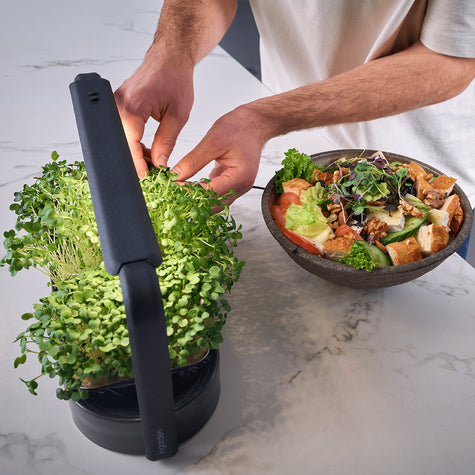The history of microgreens can be traced back to ancient Asian cultures . This was especially true for Chinese sailors, who discovered the nutritional benefits of sprouting seeds like soybeans during times of scarcity at sea. These sprouts provided essential vitamins, particularly vitamin C, which was crucial for fighting diseases like scurvy. The Chinese sailor Zheng He further developed this practice by equipping his ships with vegetable gardens to ensure a constant supply of fresh, vitamin-rich sprouts, thus setting a precedent for their use in maritime nutrition. This ancient tradition spread throughout Asia and became an integral part of the diet in Korea and Japan, where sprouts were valued for their health benefits.
Sprouts and western explorationDuring the Age of Discovery, Western seafarers faced health challenges on long voyages due to vitamin deficiencies. Unlike Asian sailors, who consumed vitamin-rich sprouts, Western sailors suffered from scurvy until they began using citrus fruits. However, the concept of using sprouts as a fresh food source gained traction, and early experiments in Europe and North America explored seeds such as alfalfa and radish for their nutritional value. These early insights into sprouting laid the foundation for the later development of microgreens in the Western diet.
Modern development of microgreensIn the modern era, microgreens gained popularity in the culinary world, beginning in the 1980s in California, a center of culinary innovation. Chefs introduced their use in upscale restaurants, recognizing their intense flavor and aesthetic appeal. Alice Waters' commitment to fresh, locally sourced ingredients led her to experiment with young vegetable seedlings and discover that these tiny greens offer impressive flavor and striking visual presentation.
bosses Craig Hartman and Michael Clark They were instrumental in the early introduction and experimentation with microgreens. Craig Hartman, known for his work at Cliff House in San Francisco, began using microgreens to enhance the visual and flavor profiles of his dishes. His innovative use of these young plants garnered attention and admiration within the culinary community.
Michael Clark, who worked with Hartman, also recognized the potential of microgreens. Together, they experimented with different seeds and developed techniques for growing and harvesting microgreens at their peak of flavor and nutritional value. Their collaboration and dedication helped refine the use of microgreens and establish them as a staple in gourmet cuisine.
In the 1990s, microgreens evolved beyond simple garnishes to become essential ingredients in gourmet dishes. Their concentrated flavors, vibrant colors, and textures made them favorites among chefs nationwide. This growing awareness led to increased consumer demand, prompting more chefs to incorporate microgreens not just as decorative elements, but as key ingredients in their culinary creations. This culinary trend brought microgreens to the attention of the general public and led to experimentation with various varieties such as kale , arugula , and radishes .
Commercialization and researchIn the early 2000s, microgreens experienced significant commercialization. Building on their initial popularity with chefs, microgreens began to attract the attention of commercial growers and entrepreneurs. Techniques for cultivating microgreens in controlled environments, such as hydroponics and indoor farming, were refined to ensure consistent quality and year-round availability. This period marked a turning point, as microgreens transitioned from niche culinary ingredients to mainstream sensations.
Scientific research in this era emphasized the Microgreens have a superior nutrient content compared to mature plants. Studies have highlighted their high levels of vitamins, minerals, and antioxidants. For example, microgreens have been found to be exceptionally rich in vitamins C, E, and K, as well as essential phytonutrients such as beta-carotene and lutein. These nutrients are responsible for their known for their antioxidant properties and potential health benefits, microgreens have established a reputation as a nutrient-rich superfood.
The efforts of Hartman and Clark, along with the scientific confirmation of the health benefits of microgreens, boosted their acceptance in both culinary and health-conscious circles. Their work and subsequent research spurred the growth of the microgreens industry, making these small green plants an integral part of modern nutrition and a symbol of innovation in both agriculture and the kitchen.
By combining culinary creativity with scientific research, microgreens have established themselves as a versatile and valuable addition to both professional kitchens and home gardens. They promise to remain at the forefront of culinary and nutritional trends by offering a blend of flavor, health benefits, and sustainability.
Sustainability and future trendsMicrogreens offer sustainable benefits through efficient water use and minimal space requirements, making them ideal for urban farming and vertical farming. Their ability to thrive indoors year-round ensures a steady supply of fresh greens, regardless of seasonal changes. Future technological innovations promise to further improve cultivation practices, making microgreens more accessible and environmentally friendly. Culinary innovations are continuously expanding their applications in diverse dishes, while educational efforts are promoting their nutritional benefits and ease of home cultivation.
Microgreens have transcended their origins as survival food and become a culinary and nutritional force. Their discovery and development showcase a journey of resilience and innovation, catering to the modern taste for fresh, nutrient-rich foods. Whether you're a chef exploring new flavors or a home gardener seeking nutritious additions to meals, microgreens offer a rewarding experience. Begin your microgreen journey today to discover their flavors, health benefits, and sustainable appeal.
Discover the world of microgreens with your ingarden Starter Kit , which offers a selection of kits, recipes , and expert tips for successful cultivation. Join our community of enthusiasts and subscribe to our blog for updates on recipes, health tips, and sustainable living.







